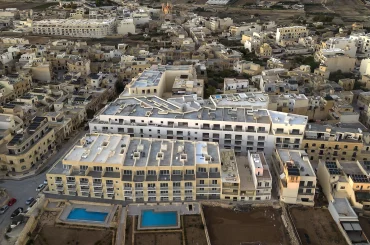Frank Fenech has grown hay in two large fields in Delimara for decades, but for the past year he has battled in court to keep hold of the leased fields even as the same fields were put up for sale.
To be specific, the fields were shown for sale on various Facebook groups around 5 months before the lawsuit intent on evicting him commenced.
The unauthorised passage proposed for sanctioning is extensive and may have an impact on the cultural landscape.
Superintendence of Cultural Heritage
Fenech has held the fields under longterm agricultural lease, and the hay he grows goes to feed cattle in his dairy farm. The fields are adjacent to the maonastery dedication to Our Lady of Tas-Silg on the fringes of Marsaxlokk, while the dairy farm is a few miles away.

A year ago the fields’ landowner filed a constitutional case seeking compensation for low rent over the years, and to have the legal provisions that protect agricultural leases declared unconstitutional – this would in turn lead to an eventual request to evict the farmer.
The stakes are high: a landowner getting rid of a farmer paying a pittance in rent would gain control over land that fetches high prices on the back of demand for recreational plots in the countryside.

The fields Fenech is fighting in court to retain were promoted for sale on various Facebook groups by Ry Zammit around 5 months before the landowner filed the constitutional lawsuit. It has since emerged in court that Ray Zammit, a businessperson whose companies include a real estate company, entered into a preliminary agreement with the landowner, Emmanuel Ciantar. It is Ciantar, as the owner, who filed the constitutional lawsuit.
According to depositions (testimony) given in court, Zammit at one point told the friar of the Tas-Silg monastery that he would sell the two fields put on the Facebook post (which are over 5,000 square metres in size) for €350,000.
That kind of price has become the norm for agricultural land that is being sold to people for rural recreation, according to research by Malcolm Borg of the NGO Ghaqda Bdiewa Attivi. Borg told the court that such land now fetches around €80,000 per tumolo (1,116 square metres).
That signifies an exponential growth in the price of agricultural land that is driven by demand for recreational plots.
Permanent or makeshift structures tend to proliferate in these recreation plots, and this is evident in a scatter of places throughout the islands. This includes a cluster of fields across the valley from the Tas-Silg monastery, where green garden shade net, new walls, access road, and other structures have appeared in the past two or three years. There was also a caravan or more than one at one point.
The friar of Tas-Silg monatery, Jose Debono, told the court in the Fenech case that he was “preoccupied” about the potential noisiness interrupting prayer or retreats if the surrounding fields become picnic spots.
The monastery’s website says that it has been hosting people on retreats for 26 years. Debono said in court that during the Euro 2020 football games last summer the noise emanating from the fields across the valley was loud enough to interfere with the silence needed during retreats or prayers.
These fields across the valley have now gotten an access dirt road some 300 metres long laid or formed without a planning permit.
A planning application to sanction the dirt road – called a “common passage” in the application description – was put in last year. It elicited strong objections from the Superintendence of Cultural Heritage and the Environment and Resources Authority.
The Superintendence wrote to the Planning Authority that the site is “located within an archaeologically and culturally sensitive location” – 400 metres from the Tas-Silg archaeological site and 150 metres from Tas-Silg fortress. It also expressed its “concern that the unauthorised passage proposed for sanctioning is extensive and may have an impact on the cultural landscape.”

“Furthermore,” it added, “works already carried out on site in an area that is known for its archaeological sensitivity may have resulted in accidental discoveries. Any unreported accidental discoveries made during works are to the detriment of the archaeological record and limit our understanding of features forming part of the cultural landscape.”
ERA wrote of its “concern” over the “creation of a long and wide beaten earth passage delineated for vehicular access. ERA officials has [sic] visited this site and finds the passageway to be excessive and incongruous with the rural landscape of this particular area.” It called the application “strongly objectionable”, and said the “site should be restored and reinstated to its original state.”
The Planning Authority rejected the application to sanction the dirt road and gate three weeks ago.

There is now a handful of pending planning applications at the fields where the application to sanction the dirt road was rejected last month. One application seeks an “animal enclosure”, another to sanction or build a rubble wall. Yet another is “to reconstruct pre-1967 room, construct stables, water reservoir and cesspit”.
In two separate cases 200 metres away, the Planning Authority three days ago refused two applications for reconstruction of rubble walls and new access gates in a field divided and sold in plots. One of those plots – 1,100 square metres in size – was being offered for sale for €255,000 last year. The Planning Authority cited fragmentation of agricultural land for refusing these applications.
Meanwhile, in the case of the fields adjacent to Tas-Silg monastery held by Frank Fenech, the court has now commissioned an evaluation of the price of the fields.
Contacted for comment by this website, Fenech declined to comment, saying he said whatever he had to say in court.
Attempts to contact Ray Zammit on the phone to get comment were unsuccessful.
This is the second in a four-installment series of articles about the trend for recreation plots in the countryside, and the impact of that on farming and landscape. The next article will be an in-depth analysis of the law and recent judgements in the Maltese constitutional courts and the European Court of Human Rights.
Donate to Investigative Journalism
Robustly researched, professionally delivered, and sustained journalistic investigations published on this website make a difference – and take much time, effort, and resources to produce. Victor Paul Borg relies on donations for income and to fund journalistic investigations. This website's donation setup itself is uniquely transparent, with targeted amounts that allow tracking of donations in real time on the page. Contribute as little as €5 to sustain active journalism that makes an impact.





